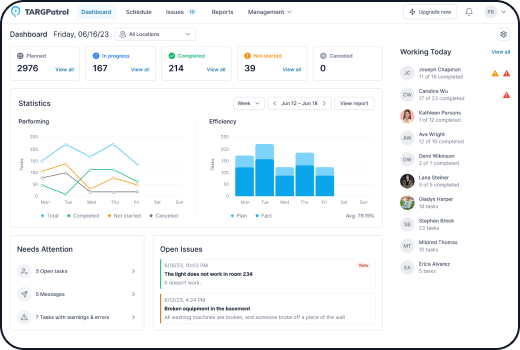Streamlining Operations with Effective On-Site Management
In today’s fast-paced world, managing operations across various locations is a critical challenge for many businesses. From security firms to cleaning services, maintenance teams, and event management companies, having an efficient system to oversee on-site activities can make the difference between smooth operations and costly disruptions. This is where on-site management comes into play—a strategic approach that leverages technology to streamline processes, improve accountability, and ensure that teams deliver high-quality service, no matter where they are.
In this article, we’ll explore what on-site management is, why it’s crucial for your business, and how modern tools can transform the way you manage teams and tasks across multiple locations.
What is On-Site Management?

On-site management refers to the process of overseeing and coordinating operations, tasks, and personnel at physical locations. It involves monitoring activities, ensuring that tasks are completed on time, and managing resources effectively. The goal is to maintain high standards of quality and efficiency, whether you are managing security patrols, cleaning services, maintenance checks, or other on-site services.
Traditionally, on-site management required manual record-keeping, physical check-ins, and paper-based reports. However, advances in technology have led to the development of digital tools that make on-site management easier, more accurate, and more efficient.
Why On-Site Management is Important
On-site management is essential for businesses that operate across multiple locations or need to ensure that remote teams are following specific protocols. Here are some key reasons why on-site management is critical:
1) Improved Accountability
By implementing on-site management processes, businesses can keep better track of their employees’ activities. This is particularly important for industries like security and maintenance, where managers need to know that guards or technicians are completing their assigned tasks. Modern on-site management tools allow managers to see who is on duty, where they are, and what tasks they’ve completed.
2) Enhanced Efficiency
Managing on-site activities manually can be time-consuming and prone to errors. By using digital tools, managers can automate many aspects of on-site management, such as scheduling, check-ins, and reporting. This allows them to focus on strategic tasks rather than spending time on administrative work, leading to greater efficiency and productivity.
3) Better Communication
Effective communication between managers and on-site staff is crucial for successful operations. On-site management systems often include messaging features, notifications, and real-time updates, ensuring that everyone stays on the same page. This can be especially valuable when sudden changes or emergencies arise.
4) Compliance and Safety
In many industries, compliance with safety regulations and standards is mandatory. On-site management tools can help ensure that all safety protocols are followed by providing digital checklists, documentation, and reports. This not only keeps employees safe but also helps businesses avoid fines and legal issues.
5) Data-Driven Decision Making
With digital on-site management tools, businesses can collect valuable data about their operations, such as task completion rates, employee performance, and time spent on specific activities. Analyzing this data can help managers make informed decisions about resource allocation, process improvements, and staffing needs.

Key Components of Effective On-Site Management
Successful on-site management involves several key components that work together to streamline operations:
- Task Scheduling and Assignment
Efficient task scheduling is crucial to ensuring that all necessary activities are completed on time. On-site management systems allow managers to assign tasks to specific employees, set deadlines, and monitor progress. For example, a cleaning company can assign different areas to its team members, ensuring that no location is left unattended.
- Real-Time Tracking
Real-time tracking allows managers to monitor the location and activities of their on-site staff. This is especially valuable for security companies, where it’s important to ensure that guards are following their patrol routes. GPS-based tracking or QR/NFC check-ins provide managers with live updates on staff movements.
- Reporting and Documentation
Accurate reporting is essential for maintaining transparency and accountability. Modern on-site management tools automatically generate reports that include information about task completion, time spent on site, and any issues encountered. This documentation can be used for internal reviews, client reports, or compliance audits.
- Communication Tools
Clear communication is key to managing remote or distributed teams. On-site management software often includes built-in messaging or notification features, making it easy for managers to send instructions, updates, or alerts directly to their team members.
- Integration with Other Systems
Many on-site management tools integrate with other business software, such as HR systems, billing platforms, and CRM solutions. This allows businesses to streamline their workflows and ensure that data is synchronized across different departments.
How Technology is Transforming On-Site Management
Advances in technology have made it possible to manage on-site operations more effectively than ever before. Here are some of the key technologies that are transforming on-site management:
Mobile Apps
Mobile apps have become a cornerstone of on-site management, enabling employees to access their schedules, check in at locations, and communicate with managers directly from their smartphones. Mobile apps are especially useful for industries like cleaning services, where workers need to access job details while on the go.
QR, NFC, and GPS Check-Ins
QR codes, NFC tags, and GPS tracking are increasingly used for verifying employee presence at specific locations. For example, a security guard can scan a QR code or tap an NFC tag at a checkpoint to verify that they have completed their patrol. GPS tracking provides an even more hands-free solution, automatically recording the guard’s location.
Cloud-Based Management Platforms
Cloud-based platforms allow managers to access their on-site management tools from anywhere, providing flexibility and convenience. Data is stored securely in the cloud, making it easy to access reports, track progress, and make real-time adjustments.
Automated Reporting and Analytics
Automation simplifies the reporting process, providing managers with detailed analytics about their on-site activities. This data can be used to identify trends, improve resource allocation, and enhance overall operational efficiency.

Industries That Benefit Most from On-Site Management
On-site management is valuable across a wide range of industries, including:
Security Services: Managing patrols, monitoring guard locations, and ensuring compliance with safety protocols.
Cleaning Services: Assigning cleaning tasks, verifying job completion, and maintaining high standards of hygiene.
Facility Maintenance: Coordinating maintenance checks, logging repair work, and ensuring that equipment is serviced regularly.
Event Management: Managing security and service staff during large events, ensuring that all areas are covered and tasks are completed on time.
Healthcare and Senior Care: Monitoring caregivers, managing patient visits, and ensuring compliance with healthcare protocols.
How It Works: Step-by-Step Example in Cleaning Services
1. Task Creation and Scheduling: Managers use the platform to create tasks, attach detailed checklists, and assign schedules to cleaners.
2. Employee Notification: Cleaners receive task notifications on their mobile app with details about schedules and instructions.
3. Check-In at Location: Cleaners scan a QR code or use NFC tags at the site to verify their presence and start the task timer.
4. Task Execution: They follow the checklist in the app, marking off completed steps.
5. Incident Reporting: Cleaners log any issues they encounter, including photos, which send instant alerts to managers.
6. Task Completion and Confirmation: Upon finishing, cleaners mark tasks as completed, often with photo evidence of the work.
7. Automated Reporting: The app generates detailed reports, offering insights into completed tasks and helping managers make informed decisions.
Choosing the Right On-Site Management Solution
When selecting an on-site management solution, it’s important to consider factors such as scalability, ease of use, and the specific needs of your industry. Look for features like real-time tracking, customizable task scheduling, and comprehensive reporting tools. Additionally, ensure that the platform integrates with your existing business software for a seamless experience.
TARGPatrol, for example, offers a versatile on-site management app that caters to a wide range of industries, providing QR, NFC, and GPS check-ins, real-time reporting, and mobile-friendly tools for managing your workforce.
Conclusion: The Future of On-Site Management
As businesses continue to adapt to a rapidly changing world, the importance of efficient on-site management cannot be overstated. With the right tools and technology, companies can improve accountability, streamline operations, and deliver a higher level of service to their clients.
Investing in a modern on-site management solution is a strategic move that can transform the way you manage your team and your operations. By embracing technology, you can ensure that your on-site management processes are optimized for success, today and in the future.
Whether you’re managing security patrols, cleaning crews, or maintenance tasks, on-site management tools provide the foundation you need for better oversight, efficiency, and growth.


